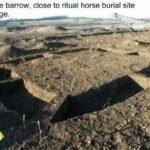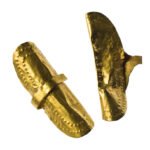Site Details:

The excavation on the northern side of Bowbridge Lane as part of the A1 expansion revealed a significant archaeological site, with features indicative of Late Bronze Age funerary practices. This period, roughly spanning from 1200 to 800 BCE, was marked by specific mortuary rituals that have been unearthed in various locations across Europe.
The features at this site were categorized into two distinct phases, with the first phase being the Late Bronze Age funerary activity. Such activities typically involved the creation of burial pits, cemeteries, and sometimes complex funerary landscapes, which included both inhumation and cremation practices.

The presence of an additional pit towards the northern end of Field 143 in the study suggests a possible extension of the funerary site, indicating that the rituals and activities may have spanned a larger area than initially uncovered. The Late Bronze Age in this region is characterized by a transition in burial practices, from individual burials to more collective or communal forms, often accompanied by various grave goods and increasingly elaborate ceremonies.
The archaeological evidence from such sites provides valuable insights into the social structure, beliefs, and practices of the communities during this era. The analysis of the remains and artifacts found within these features can offer clues about the status of individuals, the community's approach to death and the afterlife, and their connection to the landscape.
The excavation near Bowbridge Lane uncovered intriguing features that hint at significant prehistoric activity in the area. The discovery of a possible structure and large pits, in conjunction with 'burnt mound' deposits, is particularly noteworthy.
Burnt mounds are archaeological features characterized by accumulations of fire-cracked stones and charcoal, typically found adjacent to a hearth and trough. These mounds are believed to result from the periodic clearing out of the trough, with the stone fragments and charcoal being cast up into a mound. The presence of such deposits often indicates activities involving the heating of water, possibly for cooking or bathing, and are commonly dated to the Bronze Age, a period marked by the use of metal and various significant cultural changes.
Although the exact date of these features at Bowbridge Lane is yet to be determined, the association with burnt mound deposits strongly suggests a Bronze Age context. This era, spanning from approximately 2500 to 800 BCE, was characterized by diverse funerary practices, including barrow construction for burials and cremations.
The Bronze Age in Britain is noted for its round barrows or burial mounds, which were part of the landscape's ritual and ceremonial aspects. These barrows often contained cremated human remains, sometimes within urns or other containers, and were integral to the period's funerary rites.
The potential structure and pits discovered could have been part of a broader complex related to these practices. The term 'funerary phase' implies that the site might have been used for rituals associated with death and burial. In the Bronze Age, such rituals could involve the creation of barrows, the deposition of cremated remains, and possibly the curating of predecessors' remains as part of ancestral veneration.
The cyclical nature of burnt mound use, as suggested by some studies, indicates that these sites were not the result of single, large-scale events but rather the accumulation of activities over time by small communities.
The interpretation of these features as 'probable Bronze Age' is supported by the typology and distribution patterns of burnt mounds across Britain and Ireland. These mounds are predominantly found in upland areas and are often adjacent to water courses, which is consistent with the location of the Bowbridge Lane site. The discovery of such a site provides valuable insights into the socio-economic systems of the time, reflecting a community engaged in both domestic and ritual activities.
"Within the 5km radius study area of the A1 scheme, features of Middle or Late Bronze Age date have only been found at Marne Barracks, Scorton Quarry and Pallett Hill Quarry, all in the Catterick area (Hale and Still 2002, 39; Manby et al. 2003, 94; Speed 2009a), while elsewhere in the Vale the evidence is limited to the vicinity of Thornborough and Nosterfield, 14km to the south of the A1 scheme (Dickson and Hopkinson 2011, 143–6; Harding 2013, 137)." A1 Leeming to Barton 2018
At Bowbridge Lane, while no visible earthwork remains, evidence points to the historical existence of a low mound. The key indicators are the survival of an ancient ground surface with a distinct circular shape and a central stone platform. These features strongly suggest that a circular earthwork once existed above, likely serving a protective role. This interpretation is supported by the fact that the deposits beneath have remained undisturbed by later farming activities, a phenomenon observed and documented in other archaeological sites, such as Ossett in West Yorkshire.
The earthwork would have been an important feature in the landscape, possibly serving as a burial mound or a ceremonial structure, common in various ancient cultures. Its presence would have marked a significant location, perhaps a place of social or ritual importance.
Over time, such earthworks can erode or be deliberately levelled, leaving only subtle traces detectable through careful archaeological investigation. The stone platform could have been part of the structure or served as a base for a monument or marker of some kind.
The circular shape of the earthwork aligns with many known prehistoric structures, which often have circular designs, reflecting a widespread architectural tradition. The protection of the deposits from agricultural disturbance implies that the earthwork was effective in preserving what lay beneath, which could include artifacts, ecofacts, or human remains, providing valuable insights into the past.
The comparison with the site at Ossett suggests a pattern of earthwork construction and use in the region, which could reflect broader cultural practices of the time. The documentation of similar sites provides a context for understanding the significance of the Bowbridge Lane site within its historical and geographical setting.
The evidence at Bowbridge Lane, though lacking an extant earthwork, aligns with patterns observed at other archaeological sites and supports the notion of a once-existing structure that played a protective role in the landscape.
The A1 scheme's 5km radius study area in the Catterick region has yielded Middle to Late Bronze Age archaeological features exclusively at three sites: Marne Barracks, Scorton Quarry, and Pallett Hill Quarry. These findings are significant as they provide a glimpse into the human activity and settlement patterns during the Bronze Age in this particular locale. The discoveries at Marne Barracks, for instance, include a Late Neolithic Palisaded Enclosure, which suggests a transition from the Neolithic to the Bronze Age with continuity in occupation or ceremonial use of the space. Similarly, Scorton Quarry and Pallett Hill Quarry have revealed evidence that aligns with the broader regional patterns of habitation and resource utilization during the Bronze Age, as indicated by the referenced studies.
In contrast, the Vale's archaeological record outside this radius is sparse, with notable exceptions near Thornborough and Nosterfield, approximately 14km south of the A1 scheme. The Thornborough area is particularly renowned for its complex of Neolithic and Bronze Age monuments, including a series of henges that are unique in their design and scale.
These henges, along with the associated cursus structures and pit alignments, suggest a landscape that was significantly modified and used for ritual activities during the Neolithic and Bronze Age periods. The Nosterfield area complements this picture with evidence of settlement and activity that likely relates to the use and significance of the Thornborough monuments.
The distinction between the archaeological findings within and outside the 5km radius of the A1 scheme underscores the relationship between Catterick and Thornborough monuments, taken as a collection, the prehistoric site of Catterick must now be understood to have equal significance to that of the Thornborough complex. The fact all or most of these remains are now lost, which more sections of Catterick approved for development, means that for many, the significance, and pride of place associated with the site will be lost.
The Bowbridge Lane barrow site, like many other barrow sites across Britain, illustrates the multifaceted use of land by ancient peoples. The barrow, a type of mound, is often associated with burial practices; however, the evidence suggests that these sites were not exclusively used for funerary purposes, and that there may be a relationship with agricultural practices.
The recurrent activity at Bowbridge Lane over an extended period indicates a place of significance for various cultural practices, which may have included ritualistic or communal gatherings. The strategic topographic position of the site, offering expansive views to the north and west, would have been highly desirable for early hunter-gatherer communities. Such locations were often chosen for their strategic advantages, such as the ability to spot approaching wildlife or potential threats, and for their symbolic importance, possibly representing power or a connection to the celestial.
The discovery of Mesolithic and Early Neolithic worked flints in Field 145, associated with the archaeological features of the site, further underscores the area's long-standing utility. These flints, including a leaf-shaped arrowhead from the Early Neolithic period, provide tangible evidence of the technological advancements and the evolving subsistence strategies of the time. The presence of these artifacts suggests that the site was used for tool-making and possibly as a temporary campsite where hunting parties could prepare and repair their equipment. The Mesolithic era, known for its microlithic flint tools, was a time of transition from a nomadic lifestyle to a more settled existence, which continued into the Neolithic period with the advent of farming.
The leaf-shaped arrowhead, in particular, is indicative of the period's innovation in tool-making. Such artifacts were not only functional but also held aesthetic value and possibly indicated the status of the bearer. The craftsmanship required to produce these tools speaks to the skill and knowledge passed down through generations, reflecting a profound understanding of the materials and techniques used.
The archaeological record at Bowbridge Lane, therefore, provides a window into the past, revealing the continuity and change in human activities over thousands of years. It highlights the adaptability and ingenuity of early societies in Britain, who utilized the natural landscape to its fullest potential, leaving behind a legacy that continues to inform and fascinate modern archaeology.
Site Gallery
Gallery Empty













